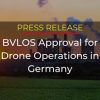Regulators have accepted that drones are a permanent part of our skyscape. And this makes the path to autonomous drones playing a large role in commercial and industrial ecosystems is that much shorter. In fact, it’s already happening.
According to a recently-released Federal Aviation Administration (FAA) report, the number of commercial drone registrations is growing far faster than expected. Staggeringly faster, in fact. In 2018, approximately 175,000 new drones were registered with the FAA, expanding the pool of licensed drones to 277,000 (a jump of 170%). To get an idea of the sheer scale of this fleet, the total number of commercial passenger aircraft in the world is somewhere around 23,600.
2018’s commercial drone growth spurred the FAA to radically revise its forward-looking numbers. Today, the agency is expecting some 825,000 registered drones by 2023. What’s more, the agency has stepped up efforts to quickly rollout an Unmanned Aircraft System Traffic Management – the drone parallel of the system that controls commercial air traffic in US airspace – to effectively manage the burgeoning drone population.
Despite notable and vociferous voices of dissent, and legitimate concerns about the ecological impact of swarms of drones operating 24/7 over populated areas, the drone regulatory climate is definitely softening. And advocacy groups like the Commercial Drone Alliance continue to lobby for ever-looser regulations. This means that commercial drones will undoubtedly be dramatically impacting our lives in the foreseeable future.
It Just Gets Better: Drones Go Mainstream
In what was perhaps the biggest shot in the arm ever for the commercial autonomous drone industry, the FAA last month granted Google-backed Wing a coveted “air carrier” status, which enables the company to launch delivery services beyond operator line-of-sight.
This unique status Wing received allows its autonomous drones to operate under regulations originally conceived to cover charter flights. This is significant because when the company’s drones were classified as drones, they couldn’t charge money to deliver items over distances that exceeded the line of sight of their drone operators. Now, the company is already planning to launch an autonomous package delivery service in the coming months in Virginia.
Amazon, too, continues to ramp up its autonomous drone capabilities. An Amazon Prime Air autonomous drone made its maiden delivery way back in 2017, and the company continues to ramp up its air infrastructure – breaking ground for a major air hub just last week.
Moreover, just last month a UPS subsidiary kicked off an autonomous drone-based medical delivery service for North Carolina hospitals. Operating without human intervention, the drones deliver medical samples in a tenth of the time it would take a ground vehicle – potentially saving lives.
What Does This Mean for Industrial Autonomous Drones?
With drone licensing skyrocketing and the biggest players in the global economy investing heavily in drone infrastructure and technology, even regulators understand that the “proof of concept” stage for autonomous drones has long past.
Today, both commercial and industrial players in numerous and diverse sectors are actively seeking to leverage field-proven autonomous drone technology to streamline operations, lower cost of services, and enhance safety and security.
Sources:
- https://www.wired.com/story/ups-matternet-drone-delivery-north-carolina/
- https://www.cincinnati.com/story/news/local/boone-county/2019/05/08/amazon-prime-air-cvg-cargo-hub-boone-county-cincinnati-airport-aero-parkway/1139710001/
- https://www.dailymail.co.uk/sciencetech/article-6990329/Expert-says-drone-deliveries-skies-incessant-buzzing.html
- https://www.bostonglobe.com/opinion/2019/05/10/coming-soon-attack-delivery-drones/SHaRUZNJIgwnGHOmObanwK/story.html
- https://www.faa.gov/data_research/aviation/aerospace_forecasts/media/FY2019-39_FAA_Aerospace_Forecast.pdf
- https://www.faa.gov/uas/research_development/traffic_management/
- https://www.nextgov.com/emerging-tech/2019/05/faa-predicts-commercial-drone-market-will-triple-2023/156743/
- https://www.wired.com/story/drone-delivery-services-are-actually-finally-almost-here/
- https://www.bostonglobe.com/opinion/2019/05/10/coming-soon-attack-delivery-drones/SHaRUZNJIgwnGHOmObanwK/story.html





